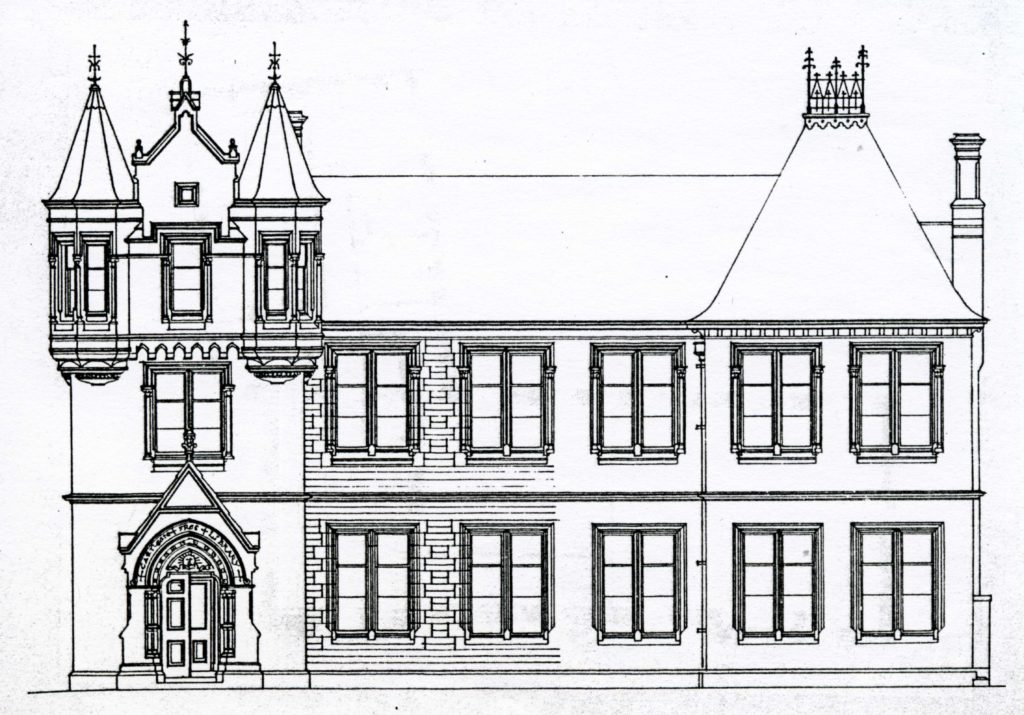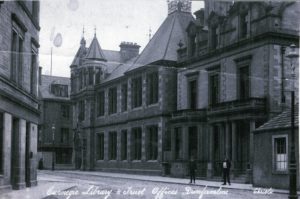The Evolution of Dunfermline Carnegie Library
Category: #Carnegie100, Blog
This blog post is part of our #Carnegie100 series, marking the 100th anniversary of Andrew Carnegie’s death and celebrating his libraries legacy.
Fit for purpose: The evolution of Dunfermline Carnegie Library
by Sharron McColl, Local Studies Supervisor, DCL&G
On 29th August 1883 the world’s first Carnegie Library was opened in Dunfermline. In the same year, Karl Marx had been buried in London and Mussolini was born in Italy. Across the Atlantic Buffalo Bill was presenting his first Wild West Show while, in Britain, the Post Office had just introduced its parcel delivery service. Nearer to home, work was beginning on the construction of the Forth Rail Bridge, while in the countryside, foot-and-mouth disease was rife.
The opening of the new public library was regarded as the most significant local event of the year. Two years previously, the foundation stone had been laid by Andrew Carnegie’s mother. A public holiday had been declared and thousands of Dunfermline people welcomed Carnegie back to his home town. The millionaire and philanthropist had contributed £8,000 to building in what was to the first of over 2,500 Carnegie-funded libraries in the English speaking world.
Architecture
The architect chosen to design the new library was J C Walker, an Edinburgh man whose firm was also responsible for the recently completed Town House. His building, executed in a style described as “Domestic Tudor”, was intended to blend with the existing architecture of an historic part of Dunfermline.
It consisted of a library room, a gentleman’s reading room. A ladies’ reading room, a recreation room, a smoking room and a librarian’s dwelling. It took over two years to build and was described by the local newspapers as “an architectural, as well as an intellectual, acquisition to the town”.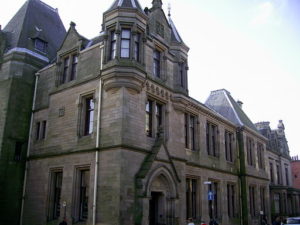
The first librarian
Alexander Peebles, an Edinburgh bookbinder, was chosen from over 250 applicants to be the first librarian. His salary was the princely sum of £70 per annum, with a house with free gas and coals. John Carmichael, the Town Drummer, was engaged to supervise the reading rooms in the evenings and a boy was employed, at four shillings per week, to assist the librarian.
Success and challenges
In its early years the library was an undoubted success. At the end of its first day, the library has issued over 2,000 books. The Dunfermline Journal commented, “For the first couple of hours Mr Peebles, the librarian, and his assistant could not supply the demands to keep the counter clear while, in the evening, when the work people were set at liberty, the crush was even greater.”
The success continued and, for a number of years the annual statistics showed a steady increase in the number of books issued.
However, there were problems too. The building was soon found to be lacking in space and its layout inside unsuitable. Despite occasional contributions by the library’s founder, the amount of money available to buy new books was insufficient. Government legislation restricted library expenditure to the product of a penny rate and there was little the Town Council could do to maintain and improve the service.
By the early years of the 20th century the Carnegie Free Library was a grim and cheerless place adding little to the amenity of Dunfermline. One writer called it “the most forlorn institution which the town possesses.”
New life for the library
In 1904, the recently formed (by Andrew Carnegie) Carnegie Dunfermline Trust offered to share the management of the library with the Town Council. The flow of funds soon improved matters. A professionally qualified librarian was 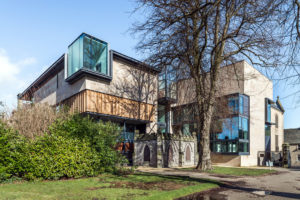 appointed and plans were laid for an extension to the existing building. Although described as an “extension” the design by architect James Shearer gave the building more than double its original space and was virtually a new library. Away went the librarian’s house and the recreation room to clear the site for a large ground floor lending hall and staircase tower to be added. Of the original building only the entrance hall and Abbot Street frontage were retained. The old “library room” was converted into the Reference Room and a special room was prepared to house the newly presented Murison Burns Collection. The outbreak of the Great War resulted in this extension not being completed until 1922.
appointed and plans were laid for an extension to the existing building. Although described as an “extension” the design by architect James Shearer gave the building more than double its original space and was virtually a new library. Away went the librarian’s house and the recreation room to clear the site for a large ground floor lending hall and staircase tower to be added. Of the original building only the entrance hall and Abbot Street frontage were retained. The old “library room” was converted into the Reference Room and a special room was prepared to house the newly presented Murison Burns Collection. The outbreak of the Great War resulted in this extension not being completed until 1922.
70 years later, in 1992, another large extension to the building was opened. The new facilities included exhibition and meeting rooms, a separate and well-equipped Local History Room and brand-new Children’s and Music Libraries.
The library today
In recent years, further changes have been necessary to accommodate the growing demands for electronic information, learning materials and cultural resources. Combining the needs of the computer age with an historic building and its historic fittings and required careful planning to ensure that the new blend in with old as much as possible.
On the 18th May 2017 Dunfermline Carnegie Library and Galleries opened its doors with a further stunning extension that’s home to a museum over two floors, three temporary exhibition galleries, a cafe, a shop, a new children’s library and the Reading Room – a local history, study and archives space, adjoining the world’s first Carnegie library.
This spectacular £12.4 million award-winning new building (EAA Building of the Year; Royal Incorporation of Architects in Scotland’s (RIAS) Andrew Doolan prize) has stunning views over the landscaped garden to Dunfermline 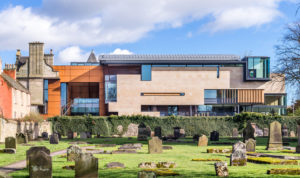 Abbey and the Heritage Quarter. Dunfermline’s past is brought to life in the new museum with fascinating stories retold through a series of special films, inspiring interviews, engaging computer games and, of course, our collections and library services are provided.
Abbey and the Heritage Quarter. Dunfermline’s past is brought to life in the new museum with fascinating stories retold through a series of special films, inspiring interviews, engaging computer games and, of course, our collections and library services are provided.
In the year that Fife Cultural Trust is remembering a local hero 100 years after his death on 11th August 1919 it is interesting to note that the Dunfermline Carnegie Trust gave a £1 million towards the new building and one hopes that its founder Andrew Carnegie who claimed “that he had never known such a small rate as the penny in the pound for public libraries, could contribute so much happiness and prosperity.” will be quietly pleased that his building is safe for another 136 years!
